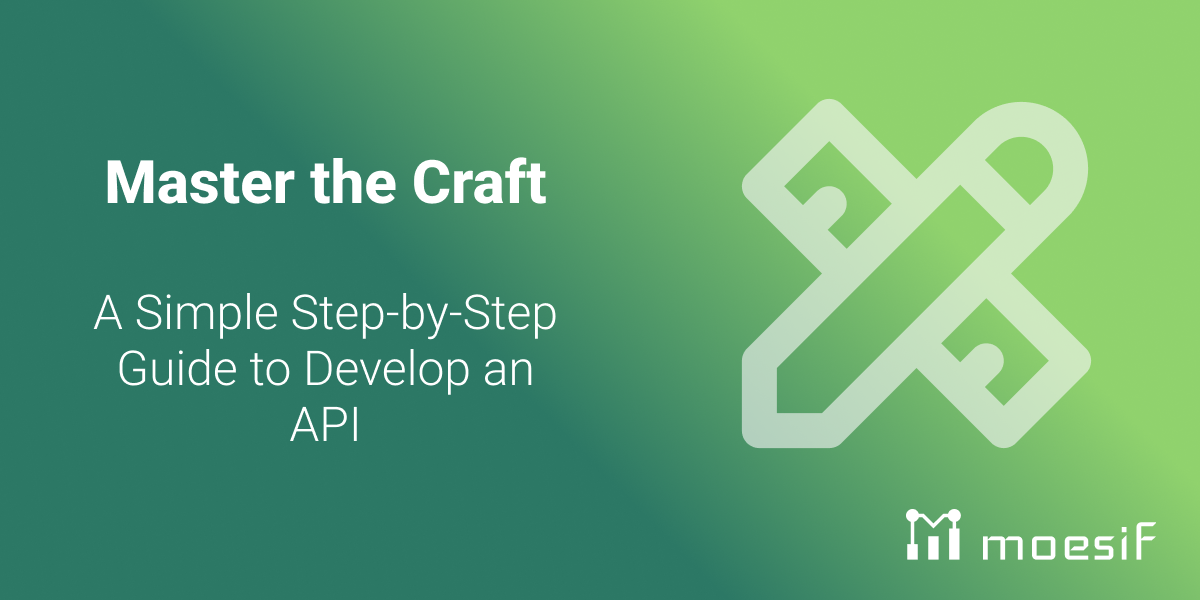Master the Craft: A Simple Step-by-Step Guide to Develop an API

This guide provides a streamlined approach to the API development process, detailing the essential phases from the initial concept to the realization of a fully operational API. You’ll discover how to plan, design, and implement your own API and ensure it’s reliable and secure. With practical insights and actionable advice, you’ll learn the nuances of API development, from understanding the needs of your users to creating a scalable infrastructure that can handle growth. We’ll also delve into the best practices for API documentation and versioning, ensuring that your API remains user-friendly and maintainable over time.
Key Takeaways
- API development is a structured process that includes requirement conception, design, implementation, testing, documentation, deployment, and performance monitoring.
- The planning and design phases of API development are crucial, involving the selection of API goals, defining functional and non-functional requirements, choosing an architectural style, and ensuring robust API security.
- Proper API monitoring and optimization post-deployment are vital. To maintain API health and user satisfaction, performance metrics must be tracked, user feedback incorporated, and continuous improvement loops implemented.

Understanding API Development

In web development, APIs connect different software components, enabling them to communicate harmoniously. The art of effective API development is a series of detailed steps:
- The initial conception of requirements
- This involves understanding the user’s needs and what the API aims to achieve. It’s the stage where you define the scope and purpose of your API.
- Designing the API architecture
- Here, you select the protocols and standards your API will adhere to. You determine how the API will be structured, the data formats it will use, and how it will handle different requests.
- Implementing the API endpoints
- At this stage, you write the actual code for the API’s functionalities. This includes setting up the endpoints that will handle requests and defining the actions that will be taken when these endpoints are accessed.
- Testing and debugging
- Before going live, the API must be rigorously tested. This involves running various test cases to find and fix bugs, ensuring that the API behaves as expected under different conditions.
- Documenting the API
- Good documentation is crucial for any API. It guides developers on how to effectively use the API and includes information on endpoints, parameters, data formats, and error codes.
- Deploying the API
- Once the API is tested and documented, it’s time to deploy it to a server where it can be accessed by users. This might involve setting up a scalable infrastructure to handle the load.
- Monitoring performance
- After deployment, it’s important to monitor the API to ensure it’s performing well and to quickly identify any issues. This includes tracking uptime, response times, and usage patterns.
The journey from blueprint to launch can be seamless or prolonged, tailored to the complexity of the task.
The process reaches its peak when an API comes to life, with source code becoming published and accessible to developers.
Application Programming Interface (API) Basics
Diving into the core, APIs conduct data flow and functionalities across diverse platforms, modern applications, and services through their API interface. Picture REST APIs and SOAP APIs as two distinguished architects in API design: REST, with its lightweight and agile structure, orchestrates performance and scalability easily, while more precise SOAP weaves complex transactions in its robust XML fabric.
The architect you choose depends on the complexity of the narrative you wish to create—whether it is simple and user-centric with REST or more complex with SOAP.
Key Components in API Development
A well-structured API clarifies digital development. It stands on the pillars of architectural style and security practices, supporting comprehensive API description and documentation. The API documentation and descriptions guide developers through the API functionalities, leading them to seamless integration and troubleshooting.
Crafting every API key and planning each response, including handling API requests, lays the foundation of a robust private API server primed to the tests of time and technology. Managing your API keys effectively is crucial to maintaining security and efficiency in your system.
Planning Your API: Goals and Requirements
As with any grand venture, the blueprint for building an API is drawn with foresight and precision. The planning stage is crucial to structure the value for users and the organization. A deep understanding of the audience, a clear vision of what creates an API’s objectives, and a thorough contemplation of the technical canvas—spanning architecture to limitations.
The plan, focused on scalability and security, is taking shape and is ready to evolve into a digital masterpiece.
Identifying API Goals
The quest for a purposeful API begins with aligning its goals with the overarching narratives of business strategy. It’s about:
- Storytelling through data exchanges
- Crafting experiences that resonate with the users
- Presenting information in a way that augments engagement and innovation.
Whether the API serves as a gateway to new revenue streams, many tools for internal developers, or a bridge to customer satisfaction, its goals should mirror its creators’ ambitions.
Defining Functional and Non-Functional Requirements
At the heart of an API’s blueprint lie its API functions—the capabilities and data it must adhere to its business capabilities. Yet, beyond functionality and data formats, the non-functional requirements exist as the guardians of performance, integrity, and security. They ensure that the API is resilient against the onslaught of errors, responds with agility, and easily processes data.
These requirements maintain the API’s quality as it evolves, guaranteeing its reliability across various platforms and languages.
Designing Your API: Structure and Security

Every layer of API design must serve its purpose, from usability to security. A consistent architecture serves as a foundation where developers can confidently build, understanding the standard patterns that make APIs intuitive to use. But it doesn’t end with mere structure; it extends to fortifying the API against the ever-present specters of vulnerabilities, ensuring that each transaction is secure.
Selecting an Architectural Style
The selection of an architectural style is a declaration of the one creating an API’s identity. It can be:
- REST, with its stateless interactions and cacheable data
- GraphQL, catering to precise data queries
- Microservices, segmenting the API into a well-defined ecosystem of services, each operating independently
The choice reflects the essence of the API’s identity, mirroring its unique needs and aspirations.
Ensuring API Security
The API gateway acts as the security guard for the API. It checks each request, including various HTTP methods, ensuring that only the worthy pass through its gates and that the data within the server remains untarnished. The API gateway controls traffic flow, preventing overload from sudden spikes or harmful attacks.
These measures create an impenetrable shield around the API, showcasing the unwavering commitment to security.
Developing and Implementing Your API
The development of an API is constantly evolving with continuous refinement of form and function. It begins with a foundation of requirements and blossoms into a structure defined by endpoints and API responses, each step closer to the ultimate goal of a seamless, functional API.
The API matures through continuous integration, testing, and version control, guaranteeing compatibility and reliability that endure the test of time.
Choosing a Preferred Programming Language
The alchemy of API development is deeply rooted in the choice of a programming language. This choice shapes the we create an API’s capabilities, influencing everything from performance to the ease of writing and maintaining code. Some popular programming languages for API development include:
- Python, favored for its rapid application development
- Java, known for its robustness
- JavaScript, widely used for web development
- Ruby, known for its simplicity and readability
- PHP, commonly used for web development
- C#, used for Windows development
- Go, known for its efficiency and scalability
Developers may call upon these languages (and many others) to bring their APIs to life.
Each language holds the potential to bring ideas to digital reality, easily creating them by leveraging its unique strengths and community support.
Writing and Testing Code
Writing code for an API balances creativity and precision, where each line of code is a step toward its functionality. As the first build an API works on takes shape, testing becomes vital to ensure each move is graceful and accurate. Tests like unit and integration tests ensure the API is ready.
Every test polishes the API for its big launch.
Monitoring and Optimizing API Performance
Monitoring becomes the telescope through which we observe the API’s journey across the digital cosmos. Performance testing and measurement tools such as Postman Monitoring and Amazon CloudWatch help ensure the API remains a steadfast vessel, navigating users’ and businesses’ demands.
Moesif steers your API to excellence.
Moesif tracks key metrics like performance and response times, helping you navigate for continued improvements. Moesif doesn’t just provide data; it takes action by setting up automated tests that ensure your API meets the highest standards. Finally, Moesif acts as a guide, providing clear alerts and dashboards that guide you through periods of high traffic and changing usage patterns. With Moesif, you can ensure the health and vitality of your API for all users to depend on.
Incorporating User Feedback
User feedback guides the API’s evolution, ensuring it remains attuned to the needs of its audience. API usage insights realistic data are gathered through tools and data models while analysis uncovers patterns and priorities that steer the API towards continuous enhancement.
Changes are carefully integrated into the API’s fabric, enriching the user experience without damaging functionality.
Summary
Our API journey is now complete! We covered everything from the basics to ongoing improvements. Whether your first API or your fiftieth, the path to creating something extraordinary is paved with intention, innovation, and introspection. May this guide be your light and guide you to API expertise.
As you embark on this adventure, remember that each API is a living entity that grows with your business. It requires nurturing through careful planning, vigilant security measures, and thoughtful design choices. Continue to engage with your users, gather feedback, and use it to refine your API. Be ready to adapt and evolve with the ever-changing landscape of technology and user needs. With dedication and foresight, your API will not only meet needs but exceed expectations, becoming an indispensable tool in the digital ecosystem. Here’s to your success in the dynamic world of API development!
Empower your API management with Moesif’s cutting-edge governance and monetization features. Govern user access and enforce quotas efficiently, while unlocking new revenue streams through flexible, usage-based billing models. Seamless integration ensures your API’s security and financial growth. Start revolutionizing your API strategy today by signing up for Moesif’s free trial, and take the first step towards optimized control and monetization of your digital services.







